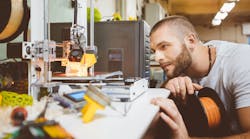In layman’s terms, 3D printing is the process of processing and printing materials such that they have a tangible, physical presence—i.e., with length, width, and depth (three-dimensional). As opposed to conventional printing which uses paper and ink, materials used in 3D printing can be sandstone, ABS plastic, nylon, or even metals. This variety of materials used means that 3D-printed creations can be applied in almost every aspect of our lives. Below are five positive effects of 3D printing on our society:
3D Printing Innovations Will Revolutionize Manufacturing
With widespread access to 3D printing equipment will come the ability to purchase and print items from the internet in real time. For instance, if you need a custom-made cover for your smartphone, all you will need to do is visit an online store selling the same and get its technical prints. Then, you can choose the color you want (maybe putting your name on it for good measure), download the final design to your computer, and subsequently print it out.
Currently, most companies charge for their designs, but it’s not as much as you would have to pay if you bought it via retail with the accompanying shipping costs. Notably, objects like smartphones and TV sets won’t be printable, but most household items will; this means that manufacturers will have to change their production systems.
3D printing has opened a customization industry. Engineers can create specialized prototypes and products for exact use cases.
Increased Mass Personalization of Products
As 3D printing innovations become more diverse with continuous advancements in technology, companies will be able to personalize products to suit the individual needs of their customers. As with the aforementioned phone covers, this mass personalization will take place without any corresponding labor costs as customers will be in charge of customization. Consequently, manufacturers will spend less on design and prototypes as these functions will be partially transferred to the customers’ home offices.
Nonetheless, some may argue—and rightly so—that mass personalization due to widespread 3D printing will lead to unemployment, so it’s not a good thing on all fronts.
Cheaper Medical Care
The use of 3D printing in the medical field has grown over the last decade, and the future looks even brighter. Very soon, scientists will be bioprinting blood vessels if researchers at Harvard University have their way. If this happens, it will open the door to the printing of body tissues and skin cells that will go a long way towards alleviating the suffering of millions of patients with blood diseases.
Additionally, researchers from the University of Toronto are working on the necessary infrastructure to allow 3D printing of prosthetic sockets. If this goes through, it will lead to reduced prosthetic prices—a relief for those who wear them.
Healthcare has changed dramatically under 3D printing. Doctors can turn advanced image scans into pre-op planning tools. The image above is of a hip that can be used for educational medical purposes.
The Rise (and Rise) of Open-Source Designs
3D printing uses Computer Aided Design (CAD) software, which requires human input both in the back and front ends. Of course, for you to print an item on your home 3D printer, someone has to create the basic designs which are typically stored in the CAD file. Currently, manufacturers and designers sell their CAD files to interested individuals who are, in fairness, not numerous.
However, there are some sites, such as Thingiverse, that bring together creatives and designers under open-source principles. There, users share their print designs, and the rights to use them, to other users on the cheap—way cheaper than major companies charge. As a result, members save lots of time as they don’t have to learn the basics of 3D printing before they can customize and print the items they need. We expect more and more open-source communities to pop up in the future as 3D printing gains more mainstream acceptance and popularity.
Reduction of Environmental Pollution
As things currently stand, goods are manufactured in totally different places from where they are consumed—sometimes on different continents altogether. To get to the end users, these goods have to be transported, whether via plane, ship, train, or road, all of which use fuels and cause emissions that are harmful to the environment.
With widespread 3D printing, most goods will be designed on computers and “manufactured” in the homes of consumers, thus reducing both the costs and environmental impacts of transportation. Admittedly, 3D printing prices are quite high at this time, but they won’t stay that way forever. Soon enough, the prices of 3D printers and materials will fall as the demand and supply increase.
It is a fact that universal use of 3D printing technologies won’t happen soon, what with the natural human opposition to change. However, all signs are that we are headed that way, so if you're interested, now is the time to enroll in a 3D course. You may be lucky to land a 3D printing job worth hundreds of thousands per year in the near future.
And that's all we have about 3D printing, folks. But of course, the discussion doesn’t end there. Chip in with your two cents in the comments.
Lucas M. Cappel is a human culture educator from New York City who enjoys modern-day technologies. Learn more by checking out his website: Besttechexpert.guide.



